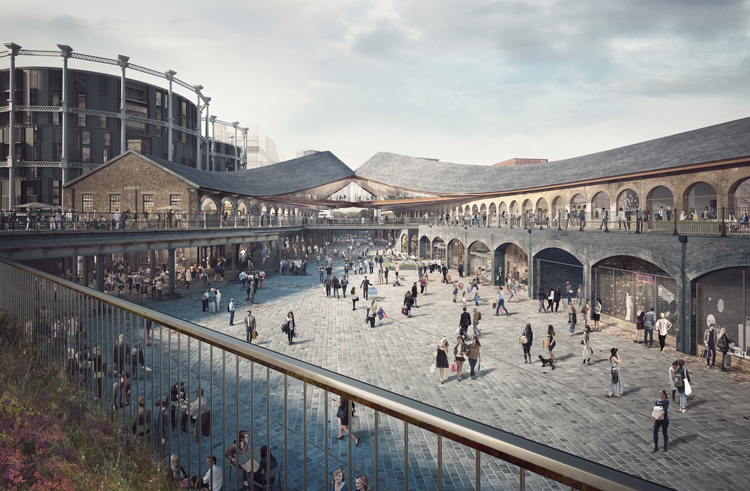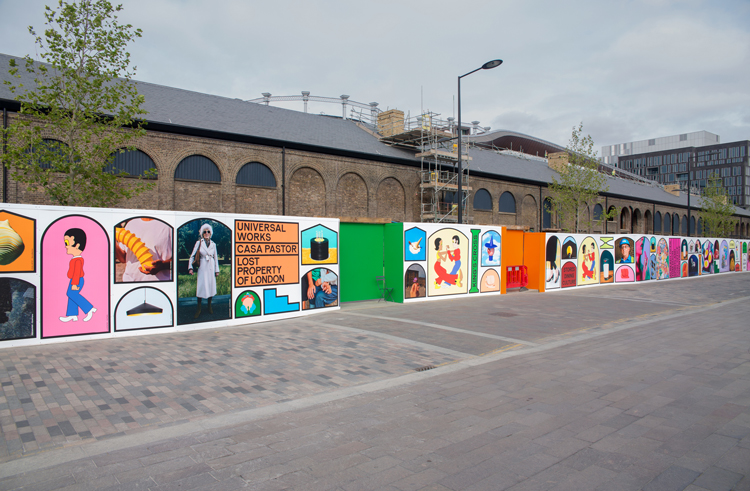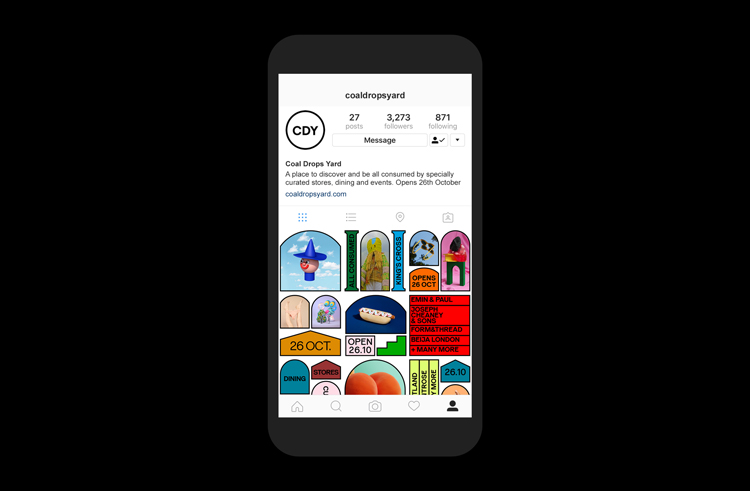Coal Drops Yard branding: “It’s not just fancy shops – it’s a public space”
The North London shopping destination, which opened last month, is the culmination of a four-year architectural and design project completed by Heatherwick Studio, featuring clothes brands, restaurants, gyms, open spaces and more.
The brand identity designed by Droga5 looks to sell the district as an alternative cultural destination that “redefines consumerism” and is open to everyone.
We speak to the agency about reaching out to the King’s Cross community, making Coal Drops Yard stand out from “homogeneous” shopping centres, and the conflict between luxury shops and public spaces.
In October, a vast new shopping and leisure district opened in Central London. Based in King’s Cross, Coal Drops Yard is a major project completed by designer Thomas Heatherwick, and is home to high-end shops from brands like Aesop and Cubitts, lauded restaurants like Barrafina and quirkier facilities, like soon-to-open Facegym – a gym specifically for exercising the muscles in the face.
Coal Drops Yard visitors also benefit from the abundance of outdoor space. Heatherwick’s team designed two “kissing” arch-shaped buildings, repurposing two existing Victorian warehouses and railway stations that were built in 1850 and used to receive coal from the North of England. This leaves a big, open courtyard in the middle, a feature rarely found in gargantuan shopping centres.

King’s Cross’ new quirky, bohemian cultural destination might well be an antidote to the Westfields and the Bullrings, but it is not a spot for bargain-hunters. While the public are free to walk around in and enjoy the spaces, many of the designer shops, from Tom Dixon furniture through to Fred Perry clothing, could hardly be classified as accessible to everyone. While anyone is able to roam and window-browse, the high price of Coal Drops Yard’s products could be a barrier or deterrent for many visitors.
But Coal Drops Yard’s branding suggests otherwise. The new shopping district has been given an identity and launch campaign by advertising agency Droga5, which gave it a colourful and “eclectic” brand filled with shapes, vertical text and random photography to represent the “diversity” of King’s Cross, while breaking away from the look of “corporate” shopping centres.
“You get cookie-cutter, homogenous shopping malls dropped into any area, whether it’s London, Sydney or the United States (US),” says Chris Chapman, head of art at Droga5. “We wanted to show that people can have different experiences here, retail ones and non-retail ones.
“There are community meeting spaces, and areas to sit in with a packed lunch – so people don’t have to go to a fancy restaurant or shop,” he adds. “We’ve tried to visually communicate this variety in an eclectic way.”

The branding, made up of photography and graphics shot and designed by local artists, aims to represent how Coal Drops Yard is a “public space” where “there is something for everyone”, Chapman says.
“The design of the space tries to make everyone feel welcome,” he says. “It’s a porous, big, open space, that isn’t shut off by entrances guarded with doormen. It’s meant to feel like part of the [King’s Cross] community.”
To reflect this, the branding takes cues from the architecture of the space itself. The identity features multiple two-dimensional (2D) shapes inspired by objects used in architecture and building, such as pillars and stairs. A semi-cylindrical arch is the most-used shape, nodding to the arch-shaped buildings that Coal Drops Yard centres around.
These various shapes are used as holding devices for different graphics and photography, created by 25 local illustrators, photographers, animators and artists, with background colours added and a black outline around the shapes to accentuate their contents.

The local artists included Central Saint Martins (CSM) art and design graduates, as the university is located directly opposite Coal Drops Yard in Granary Square.
Droga5 commissioned the various artists to capture things related to King’s Cross, such as lifestyle shots of the area and portraits of local people, while “non-consumerist” motifs were also created, such as graphics of packed lunches to demonstrate what people can do in the space.
“We wanted to reflect the local community in the identity, so we avoided making all the imagery models in fur coats,” says Chapman.
A broad colour palette of shades of purple, blue, green, yellow, orange, red and pink has been used, with sans-serif typeface Reader, created by type foundry Colophon, set in black.
Text and copy is kept to a minimum, such as brand names or the campaign’s three main promotional words “stores, dining and culture”, but where it does appear it is also set in black, against a coloured background, encased within rectangle shapes then outlined in black.
Main typeface Reader is “quite a basic type”, says Chapman, but the studio has given it “variety” through creating different versions of letters and characters, with different stroke thickness.

Text and imagery appears vertically as well as horizontally, as a backlash against the regular structure of information found on an advertising poster, says Chapman, in a bid to let visitors’ eyes “ramble” rather than giving them a structured direction. This aims to represent what the layout of Coal Drops Yard encourages visitors to – explore rather than be led into a “hard purchase”.
“We wanted to limit ‘corporate brand control’ and have as few rules as possible,” Chapman says. “We had to trust the identity was strong enough to play around with.”
“Normally the hierarchy of a campaign poster makes it easy to know where the eye should go,” he says. “The logo will be at the bottom right, with a clear headline to hook people in, then as they read through, they end up on the logo. It’s normally a very controlled and functional thing.”

“Instead, we pared information back and broke it up into only what was necessary, and trusted that people would find what they wanted to find,” he adds.
While this colourful look might be eye-catching and different, Chapman says that the layout makes the visitor need to work harder and make up their own minds as to what they want to do in Coal Drops Yard, rather than being “pushed into a hard purchase”.
“The identity is quite jarring, you don’t know where to look,” he says. “It’s harder to absorb the information but there’s a reward when someone finds their way through it. It also stands out and makes people notice it. We wanted people to explore Coal Drops Yard and see brands’ presence, rather than being pushed into buying everything.”
In producing an alternative and perhaps slightly chaotic identity, Droga5 looks to represent an alternative view of consumerism and shopping.
“It’s about redefining consumerism,” Chapman says. “Going to Coal Drops Yard is definitely a form of consumption, but we want to make people more mindful of how they consume stuff. Going there rather than just mindlessly buying something on your phone is an all-over experience, from shopping to the space’s design to its history.”

While Coal Drops Yard is certainly aimed at a discerning consumer, the brand campaign, which includes graphic hoardings spanning the perimeters of the shopping district, next to King’s Cross tube station, aims to tell the public that everyone can enjoy it, according to Chapman.
“We wanted to make it appear as un-elitist and un-gentrified as possible,” he says. “Coal Drops Yard is what it is – and it is a shopping centre. There are some quite fancy stores in there that many of us can’t afford to buy things from – but it’s also a place where there’s something for everyone.”
Having opened so recently, it is not yet clear how truly accessible the space will be. Neighbouring Granary Square – an open square filled with restaurants, cafés and Central Saint Martins art college – has come under fire since its opening in 2012 as an example of a “pseudo” public space: one that appears public, but is owned by a private corporation, restricting freedom for those who go there.
Reports have previously been made about similar squares in London, where homeless people have been moved along, and photographers have been asked by security guards not to take photos without permission.

But Chapman says, while full of expensive shops and restaurants, the developers want it to be used for recreational as well as consumerist purposes – only time will tell whether Coal Drops Yard attracts a diverse mix of people, or whether it will be restricted to a wealthier audience.
“There was a genuine concern on behalf of the client, Argent, to make people feel welcome and make it as accessible as possible,” says Chapman. “We didn’t want it to feel like some cold, cut-off, swanky place – it has to feel like a public space.”
The Coal Drops Yard branding has now rolled out across print materials such as advertising posters, promotional books, and graphic hoardings in King’s Cross, and digital platforms such as the Coal Drops Yard website and social media. It is now open at King’s Cross, London N1C 4DQ.









Some of the worst ‘public’ design I’ve seen in a very long time. Is this really the future of graphic communication in the UK?
Hi, I just wondered if the comments about ‘accessibility to everyone’ were made by your editorial staff and what the context was? I was there a couple of times during the summer before the place was fully open and saw what I took to be families from the surrounding communitiy using the fountain courtyard areas for play and recreation but I was not aware of an elitist shopping centre any different from other parts of London. I wasn’t expecting retailiers like Tesco or Poundland to move into the area but often developments like this don’t make returns for the companies that build them unless they are very successful or expensive. Juat wonder what is behind the comments? At the moment the area is a bit of a ‘must go to’ place mainly because of the new bars and restaurants opening. I gave up after finding the queue for Dishoom was one and a half hours and came back another day but I think the plae will settle down to its own pace eventually when the glitz has worn off. And agree with David Evans comments, the graphics are rubbish. Maybe they should have employed a proper wayfairing company.
Hi Neil,
Sorry, I don’t understand your question. The comments around accessibility were made by our interviewee for the piece, not Design Week editorial staff. Can you clarify please?
Thanks,
Design Week team
meant to say ‘wayfinder’ not wayfairing in the last sentence.
Sarah, hi, at the beginning of the piece the following statement appears: ‘the designer shops, from Tom Dixon furniture through to Fred Perry clothing, could hardly be classified as accessible to everyone’. This is not attributed to anyone and after that all the comments are by Chris Chapman of the design company who implemented the graphics. My point was who said ‘it could hardly be classified as accessible to everyone’?
Hi Neil,
Thanks for the comment – we have editorialised the introduction and this is our point of view, but this isn’t up for debate really. Many of the designer brands have very highly-priced products, which would no doubt be inaccessible to a portion of the public. We’ve clarified this with an extra line, adding that anyone is free to window-browse but the high price point might be a deterrent for some people.
Thanks,
Sarah
As a customer experience researcher, I’ve been intrigued to visit Coal Drops Yard for a while now, so went along yesterday. Architecturally, it’s a really interesting space, and great to see London’s industrial heritage being revamped for a modern age. In summer, I can envisage it being popular, as it’s open and has variety of food options. But as an all-year-round retail proposition, I worry for it. Many of the units are painfully small, and don’t allow space for many shoppers to browse. With such high prices, conversion rates will be low, so these retailers will need bags of footfall to support them. I don’t see that happening – the current mix is too eclectic to provide a focus for a visit, beyond simple curiosity. It may win some tourist trade, but Camden Market is way more accessible from a financial perspective.
My advice would be to rethink the retail mix, and find opportunities for better known brands to attract a broader clientele. i know it’s early days, but yesterday it was VERY quiet, even in the run up to Christmas.
PS: agree with earlier comments from others – the way finding signage is poor and frankly ugly. If you want to go the functional route, see how Swiss rail do it!